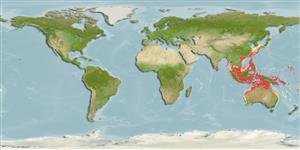Common names from other countries
>
Ovalentaria/misc (Various families in series Ovalentaria) >
Opistognathidae (Jawfishes)
Etymology: Opistognathus: Greek, opisthe = behind + Greek, gnathos = jaw (Ref. 45335); to the very elongate upper jaw of the type species of the genus, Opistognathus nigromarginatus (Ref. 128653); castelnaui: Named for the French diplomat and ichthyologist Francis-Louis de Castelnau (1812-1880)..
More on author: Bleeker.
Environment: milieu / climate zone / depth range / distribution range
Ecologia
marinhas demersal; intervalo de profundidade 20 - 100 m (Ref. 559). Tropical
Indo-West Pacific: eastern Australia to the Ryukyus, Taiwan, Philippines, Malaysia, and Indonesia.
Tamanho / Peso / Idade
Maturity: Lm ? range ? - ? cm
Max length : 25.0 cm SL macho/indeterminado; (Ref. 559)
Descrição suscinta
Chaves de identificação | Morfologia | Morfometria
Espinhos dorsais (total) : 11; Raios dorsais (total) : 14; Espinhos anais: 3; Raios anais : 14; Vértebras: 28. This species is distinguished by the following characters: elongated supramaxilla and posterior end of maxilla produced as a thin flexible lamina; upper jaw's inner lining and adjacent membranes with one or two conspicuous black stripes; dorsal half of dorsal fin usually dark except for narrow pale margin, remainder of fin pale and often with 8 or 9 evenly spaced dark blotches that extend onto basal fourth to third of fin and slightly onto dorsum; D XI,14; body with about 90-11 0 oblique scale rows; total gill rakers 28-35 (Ref. 81517).
Inhabits open sand and rubble substrates in about 20-25 meters (Ref. 48637). May be found in depths greater than 100 m (Ref. 559). Mouthbrooders (Ref. 240).
Ciclo de vida ou comportamento de acasalamento
Maturities | Reprodução | Spawnings | Egg(s) | Fecundities | Larvas
Employ mouthbrooding to care for their young (Ref. 240).
Smith-Vaniz, W.F., 2023. Review of Indo-West Pacific jawfishes (Opistognathus: Opistognathidae), with descriptions of 18 new species. Zootaxa 5252(1):1-180. (Ref. 128653)
Status na Lista Vermelha da UICN (Ref. 130435)
CITES (Ref. 128078)
Not Evaluated
Ameaça para os humanos
Harmless
Uso pelos humanos
Ferramentas
Relatórios especiais
Baixar XML
Fontes da internet
Estimates based on models
Preferred temperature (Ref.
115969): 24.1 - 28.5, mean 27.5 (based on 554 cells).
Índice de diversidade filogenética (Ref.
82804): PD
50 = 0.5000 [Uniqueness, from 0.5 = low to 2.0 = high].
Bayesian length-weight: a=0.00389 (0.00180 - 0.00842), b=3.12 (2.94 - 3.30), in cm Total Length, based on all LWR estimates for this body shape (Ref.
93245).
Nível Trófico (Ref.
69278): 3.7 ±0.6 se; based on size and trophs of closest relatives
Fishing Vulnerability (Ref.
59153): Low vulnerability (21 of 100).
